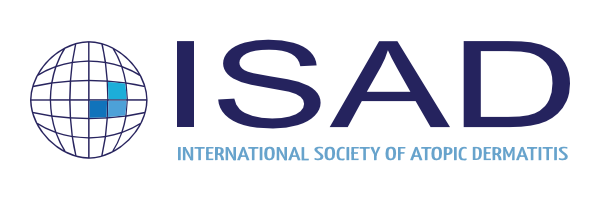SESSION 1 / New systemic treatments
Kristian REICH (Hamburg, Germany),1 Marjolein De BRUIN-WELLER,2 Brian M. CALIMLIM,3 Henrique D. TEIXEIRA,3 Meijing WU,3 Jonathan I. SILVERBERG4
1Institute for Health Services Research in Dermatology and Nursing, University Medical Center Hamburg Eppendorf, and Skinflammation® Center, Hamburg, Germany; 2Department of Dermatology and Allergology, University Medical Center Utrecht, Utrecht, The Netherlands; 3Health Economics and Outcomes Research, Clinical Development and Biostatistics, AbbVie Inc., North Chicago, IL, USA; 4Department of Dermatology, George Washington University School of Medicine, Washington, DC, USA
Overview
- Video presentation
- Presentation
- Full version download as PDF
- Ask questions to the author
Authors retain copyright.
Presentation
Background and Objective
- The Eczema Area and Severity Index (EASI) and Investigator Global Assessment (IGA) are often used as primary endpoint measures for assessing clinical response in atopic dermatitis (AD) studies1
- Other AD outcome measures, such as those assessing pruritus, AD severity and symptoms, impact on sleep, and impact on daily activities, are also used2,3
- However, it is not fully understood how a clinical response on EASI and IGA assessments translate to improvements in other outcome measures
- The objective of this observed-case post-hoc analysis was to assess relationships between common clinical response definitions (EASI and IGA) and other outcome measures at week 16 using data from a phase 2b upadacitinib trial in adult patients with moderate to severe AD
Study design
This analysis included all patients regardless of treatment received.

Outcomes at Week 16
| Measure | Concept | Score Range | Score Interpretation and Assessed Outcomes |
|---|---|---|---|
| EASI (1) | AD severity and extent | 0-72 | % improvement from baseline (50%–74%, 75%–89%, 90%–99%, 100%) |
| IGA | AD severity | 0-4 | Clear: 0 Almost clear: 1 |
| SCORAD (1) | AD severity | 0-103 | Clear: <10 Mild: 10-29 |
| POEM (2) | Symptom Frequency | 0-28 | Clear or Almost Clear: 0-2 Mild: 3-7 |
| Pruritus NRS | Itch | 0-10 | No/Minimal Itch: 0-1 Mild Itch: 2-3 |
| PGIS | Patient-Reported Severity | 0-7 | Absent/Minimal: 0-1 Mild: 2 |
| ADERM-SS (3) | Symptom Intensity | 11 items, 0–10 per item | No symptom: 0 Worst imaginable symptom: 10 |
| ADERM-IS (3) | Impact of AD | 10 items, 0–10 per item | No impact: 0 Extreme impact: 10 |
2019;35(7):1139-1148.
Results
Of the 167 patients in the intent-to-treat population, 137 had both baseline and week 16 EASI and IGA data and were included in this observed-case analysis.
| Characteristics, mean (SD) | Overall Population N=137 |
|---|---|
| Male, n (%) | 88 (64.2) |
| Age, y | 40.1 (15.7) |
| Diagnosis duration, y | 25.4 (16.3) |
| Symptom duration, y | 27.2 (16.7) |
| EASI | 31.1 (13.8) |
| IGA, moderate, n (%) | 77 (56.2) |
| Pruritus NRS weekly average | 6.5 (1.9) |
Correlation of EASI and IGA at Week 16
- Statistically significant (P<0.001) positive correlation was observed between EASI/IGA and other outcome measures at week 16, although correlation magnitudes varied greatly
- Higher degree of correlation observed with total SCORAD score (a clinician-reported measure) compared with patient-reported measures
| Correlation | EASI | IGA |
|---|---|---|
| Total SCORAD | 0.867* n=130 | 0.921* n=130 |
| POEM | 0.594* n=135 | 0.723* n=135 |
| Pruritus NRS | 0.589* n=124 | 0.628* n=124 |
| ADerm-SS items (range) | 0.476–0.584* n=87 or 114 | 0.578–0.726* n=87 or 114 |
| ADerm-IS items (range) | 0.506–0.617* n=87 or 114 | 0.539–0.667* n=87 or 114 |
| PGIS | 0.622* n=132 | 0.681* n=132 |
Pearson correlation was used for correlations among continuous measures; Spearman Rank correlation was used otherwise.
Relationship between EASI and IGA at Week 16
Statistically significant positive correlation was observed between EASI and
IGA at week 16 (0.892; P<0.001)

EASI 90%–99%, n=24; EASI 100%, n=15.
Relationship between EASI improvement and other outcomes
Higher EASI responses trended toward greater proportions of patients achieving better SCORAD, POEM, Pruritus NRS, and PGIS scores at week 16.

EASI 90%–99%, n=24; EASI 100%, n=15.
Mean ADerm-SS and ADerm-IS item scores based on EASI and IGA responses
Lower ADerm-SS and ADerm-IS item mean scores were observed with higher EASI and IGA responses at week 16.

Conclusions
- These findings suggest that there is a relationship between EASI- and IGA-based clinical response definitions and other outcomes among patients with moderate to severe AD
- Correlations of EASI/IGA with other outcome measures at week 16 suggest that response patterns may vary across the assessed domains
- Higher thresholds of efficacy (EASI 90/100, IGA 0/1) consistently led to better outcomes in pruritus, AD severity, symptoms, sleep, and other aspects of quality of life
Ask questions to Kristian REICH:
[contact-form-7 id=”3756″ title=”Ask question LIVE”]
Conflict of interest :
K Reich has served as an advisor and/or paid speaker for and/or participated in clinical trials sponsored by AbbVie, Affibody, Almirall, Amgen, Avillion, Biogen, Boehringer Ingelheim, Bristol-Myers Squibb, Celgene, Centocor, Covagen, Dermira, Forward Pharma, Fresenius Medical Care, Galapagos, GlaxoSmithKline, Janssen-Cilag, Kyowa Kirin, Leo, Lilly, Medac, Merck Sharp & Dohme, Miltenyi Biotec, Novartis, Ocean Pharma, Pfizer, Regeneron, Samsung Biopepis, Sanofi, Sun Pharma, Takeda, UCB, Valeant, and Xenoport.
M De Bruin-Weller received grants for principal investigator services from AbbVie, Regeneron Pharmaceuticals, Inc., Pfizer, and Sanofi Genzyme; honoraria for advisory board member from AbbVie, Eli Lilly, Regeneron Pharmaceuticals, Inc., Pfizer, Sanofi Genzyme, and UCB, and for consultant services from Regeneron Pharmaceuticals, Inc. and Sanofi Genzyme.
BM Calimlim, HD Teixeira, and M Wu are full-time employees of AbbVie and own AbbVie stock or stock options.
JI Silverberg received honoraria for advisory board, speaker, and consultant services from AbbVie, Anaptysbio, Asana, Dermavant, Eli Lilly, Galderma, GlaxoSmithKline, Glenmark, Kiniksa, Leo, Menlo, Novartis, Pfizer, Realm and Regeneron-Sanofi, and received research grants for investigator services from GlaxoSmithKline.
Acknowledgment
AbbVie funded this study, and participated in the study design, research, analysis, data collection, interpretation of data, reviewing, and approval of the presentation. No honoraria or payments were made for authorship. Medical writing support was provided by Maria Hovenden, PhD, and Janet E. Matsuura, PhD, at ICON (North Wales, PA), and was funded by AbbVie.

